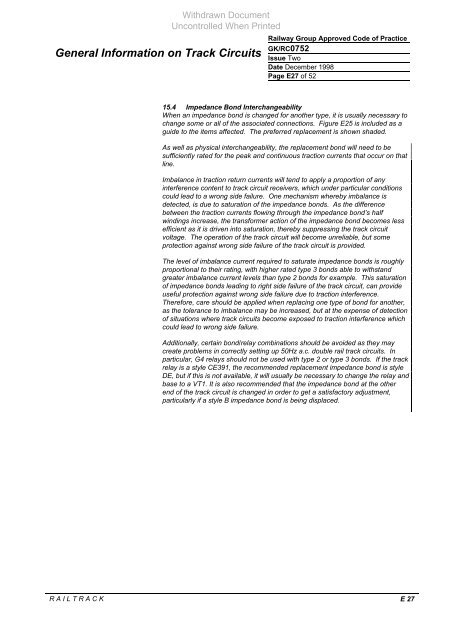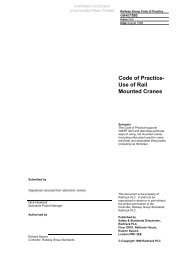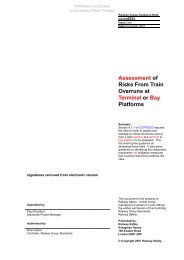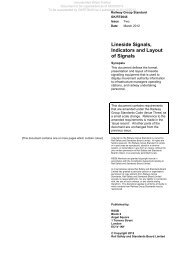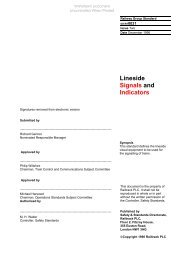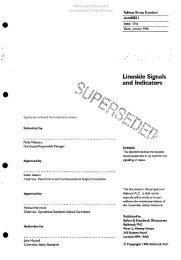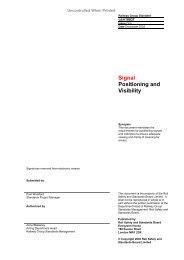General Information on Track Circuits - RGS Online
General Information on Track Circuits - RGS Online
General Information on Track Circuits - RGS Online
You also want an ePaper? Increase the reach of your titles
YUMPU automatically turns print PDFs into web optimized ePapers that Google loves.
Withdrawn Document<br />
Unc<strong>on</strong>trolled When Printed<br />
<str<strong>on</strong>g>General</str<strong>on</strong>g> <str<strong>on</strong>g>Informati<strong>on</strong></str<strong>on</strong>g> <strong>on</strong> <strong>Track</strong> <strong>Circuits</strong><br />
Railway Group Approved Code of Practice<br />
GK/RC0752<br />
Issue Two<br />
Date December 1998<br />
Page E27 of 52<br />
15.4 Impedance B<strong>on</strong>d Interchangeability<br />
When an impedance b<strong>on</strong>d is changed for another type, it is usually necessary to<br />
change some or all of the associated c<strong>on</strong>necti<strong>on</strong>s. Figure E25 is included as a<br />
guide to the items affected. The preferred replacement is shown shaded.<br />
As well as physical interchangeability, the replacement b<strong>on</strong>d will need to be<br />
sufficiently rated for the peak and c<strong>on</strong>tinuous tracti<strong>on</strong> currents that occur <strong>on</strong> that<br />
line.<br />
Imbalance in tracti<strong>on</strong> return currents will tend to apply a proporti<strong>on</strong> of any<br />
interference c<strong>on</strong>tent to track circuit receivers, which under particular c<strong>on</strong>diti<strong>on</strong>s<br />
could lead to a wr<strong>on</strong>g side failure. One mechanism whereby imbalance is<br />
detected, is due to saturati<strong>on</strong> of the impedance b<strong>on</strong>ds. As the difference<br />
between the tracti<strong>on</strong> currents flowing through the impedance b<strong>on</strong>d’s half<br />
windings increase, the transformer acti<strong>on</strong> of the impedance b<strong>on</strong>d becomes less<br />
efficient as it is driven into saturati<strong>on</strong>, thereby suppressing the track circuit<br />
voltage. The operati<strong>on</strong> of the track circuit will become unreliable, but some<br />
protecti<strong>on</strong> against wr<strong>on</strong>g side failure of the track circuit is provided.<br />
The level of imbalance current required to saturate impedance b<strong>on</strong>ds is roughly<br />
proporti<strong>on</strong>al to their rating, with higher rated type 3 b<strong>on</strong>ds able to withstand<br />
greater imbalance current levels than type 2 b<strong>on</strong>ds for example. This saturati<strong>on</strong><br />
of impedance b<strong>on</strong>ds leading to right side failure of the track circuit, can provide<br />
useful protecti<strong>on</strong> against wr<strong>on</strong>g side failure due to tracti<strong>on</strong> interference.<br />
Therefore, care should be applied when replacing <strong>on</strong>e type of b<strong>on</strong>d for another,<br />
as the tolerance to imbalance may be increased, but at the expense of detecti<strong>on</strong><br />
of situati<strong>on</strong>s where track circuits become exposed to tracti<strong>on</strong> interference which<br />
could lead to wr<strong>on</strong>g side failure.<br />
Additi<strong>on</strong>ally, certain b<strong>on</strong>d/relay combinati<strong>on</strong>s should be avoided as they may<br />
create problems in correctly setting up 50Hz a.c. double rail track circuits. In<br />
particular, G4 relays should not be used with type 2 or type 3 b<strong>on</strong>ds. If the track<br />
relay is a style CE391, the recommended replacement impedance b<strong>on</strong>d is style<br />
DE, but if this is not available, it will usually be necessary to change the relay and<br />
base to a VT1. It is also recommended that the impedance b<strong>on</strong>d at the other<br />
end of the track circuit is changed in order to get a satisfactory adjustment,<br />
particularly if a style B impedance b<strong>on</strong>d is being displaced.<br />
R A I L T R A C K E 27


